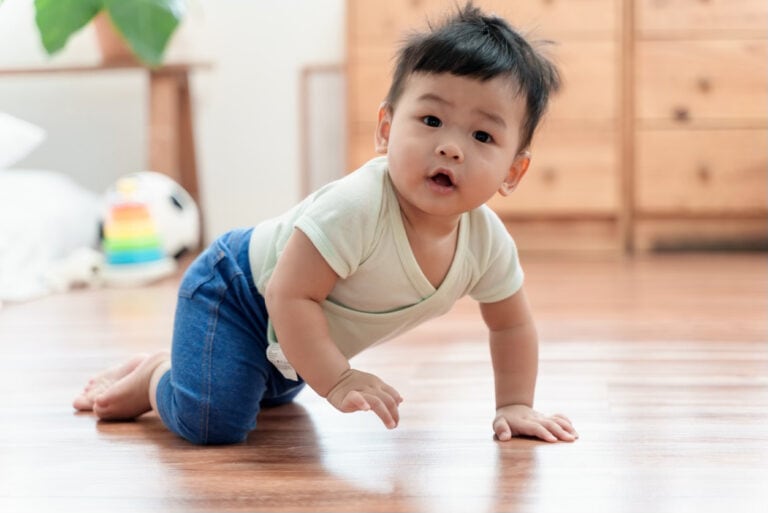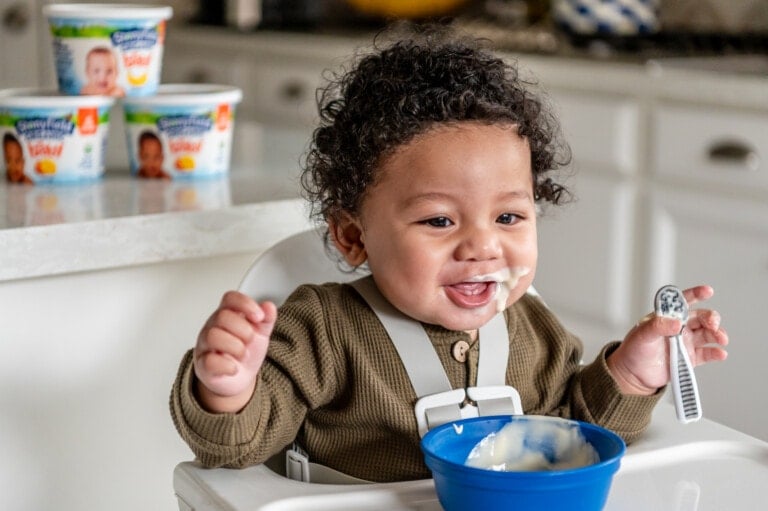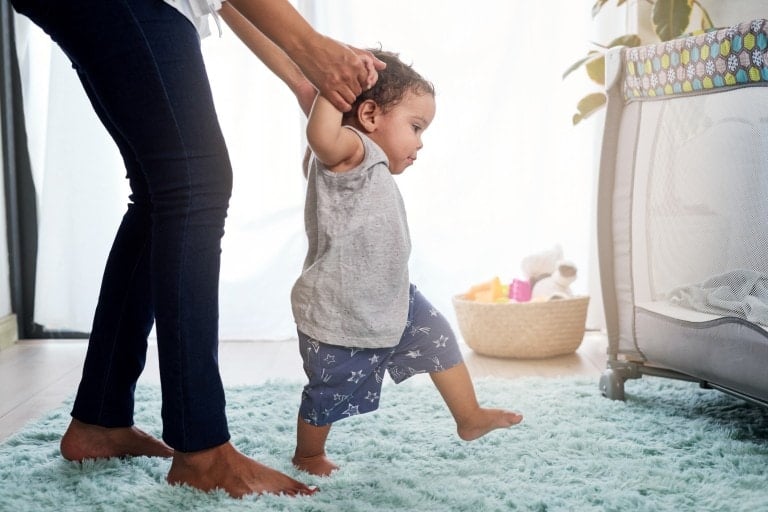It’s hard to believe your baby is already three months old. With each new month comes new and exciting changes for your baby. Watching your 3-month-old baby grow and develop brings great joy, but it can also bring questions and concerns. You may be curious about what milestones they should be reaching or what their feeding and sleeping schedule should look like. This article will help guide you through what to expect during your baby’s third month.
3-Month Developmental Milestones
At three months, your baby becomes more active and alert as they spend more time awake. With this newfound alertness, you will notice leaps and bounds in their development. Some new motor skills they will develop include:1
- Raising their head and chest when on their stomach
- Supporting their upper body with their arms when on their stomach
- Kicking their legs when on their stomach or back
- Pushing down on their legs when their feet are placed on a surface
- Swiping at and grasping toys
- Watching faces and objects as they move
Your baby will also develop some new social skills during their third month. These skills include:1
- Babbling and imitating sounds
- Smiling at familiar faces
- Playing with others, and they may even cry when the playing stops
- Becoming more expressive with their face and body
3-Month-Old Feeding Schedule
Feedings during the first three months of your baby’s life will look similar. While your 3-month-old may have more extended periods between feedings than they did as a newborn, they will still eat frequently. Your 3-month-old will typically eat every two to three hours or eight to 12 times daily. Your 3-month-old should eat about 4-6 ounces of breast milk or formula per feeding.2
Your baby may feed more frequently when going through a growth spurt, and you may wonder if they are getting enough. You will know your baby is getting enough milk by watching for these signs:2,3
- They are alert, content, and active several times throughout the day
- They are gaining weight steadily
- They have regular wet and soiled diapers, typically five to six wet diapers (or more) daily
3-Month-Old Sleep Schedule
At three months old, your baby’s sleep schedule may become more set in stone. Infants at this age typically sleep for 15 hours per day, broken up into about nine to 10 hours of nighttime sleep and four to five hours of daytime sleep.4 Your baby will typically take two to three naps daily, broken up into a mid-morning and mid-afternoon nap with an additional afternoon nap if needed. Some babies may continue to take four or five naps a day. It’s important to watch your baby for their sleepy cues.5,6
Many parents wonder, “When do babies start sleeping through the night?” The good news is at around three months old, your baby may start to sleep through the night. But that may not mean what you think it means. Sleeping through the night as an infant means sleeping for a five- to six-hour stretch before waking to feed.5 Some babies may stretch that sleep period to six to eight hours, but not all.4 It can still be normal for some babies to continue to wake every two to three hours to feed, but if you have concerns about your baby’s sleep pattern, reach out to a professional.
Daily Schedule
During your baby’s first few months, their daily schedule can be unpredictable. As your baby reaches three months old, they will start to spend more time awake, making their schedule more concrete. Their daily schedule may still revolve around their nap and feeding times, but you can create a nap and feeding schedule that works for your baby.
Your 3-month-old will still need two to three naps per day, with the first nap typically happening two hours after they have awakened for the day. Their second nap often occurs sometime in the mid-afternoon following a feeding.6
This is also the month when you can develop a bedtime routine for your baby to help make bedtime a smooth process for now and in the future. You can start this routine by picking some activities you will do every night in the same order. These can include feeding, bath time, story or song time, or a quiet-time activity.6
Health Concerns to Watch Out For?
During the first two months of your baby’s life, well-child visits become a monthly routine; however, a well-child visit is typically unnecessary at this age. Unless your child is behind on their vaccines, no shots are needed either.7
While your baby may not need a well-child visit, it is essential to seek medical help if your baby is experiencing any of the following conditions:7
- Diarrhea or vomiting causing dehydration
- Increased irritability accompanied by a fever or rash
- Skin irritations or rashes that don’t go away
- Respiratory infections such as a cold
- A fever over 100.4 degrees Fahrenheit. While a fever is no longer an emergency past two months, it may still be a good idea to reach out to your doctor if your baby develops a fever and ask what to watch out for and if you should give any medicine.
Even though your baby will not typically have a well-child visit at this age, if you are concerned about their weight, you can contact their doctor for monitoring. All babies are born at different weights and will grow at different rates. On average, babies will gain about 1 ounce per day over the first three months of their lives.12 Your doctor can tell if your baby is growing appropriately according to their pattern.
Monitor Your Baby’s Development
It is important to continue to monitor your baby’s growth and development and to see your pediatrician if you notice any of the following in your baby:1
- They don’t respond to loud noises
- They don’t notice their own hands
- They are not able to follow objects with their eyes
- They can’t grasp or hold a toy
- They can’t support their head while on their tummy or when being held
- They don’t babble
- They have trouble moving one or both of their eyes in all directions
Activities for 3-Month-Olds
As your baby becomes more alert and active, playtime becomes more engaging and fun for both of you. Your 3-month-old’s wake window typically lasts about one to three hours before they need to nap.11 These wake windows are a perfect time to work on your baby’s developmental milestones. This list will help give you some ideas for engaging play with baby:8
- Clap their hands together gently
- Gently stretch their arms wide or overhead or cross their arms
- Pedal their legs when they are lying on their back
- Have them focus on a toy and move it back and forth in front of their face for them to follow
- Shake a rattle, and let your baby search for the noise
- Talk, read and sing to your baby, and make different facial expressions for them to mimic
- Encourage supervised tummy time
- Have a variety of colorful toys in different shapes, sizes, and textures for them to engage with
Safety Tips
Maintaining a safe environment is essential at any age, but as your baby becomes more active and alert, there are new safety concerns to consider. At this age, safety tips are geared toward keeping your baby safe in their environment. This can include:9,10
- Using a slip-resistant tub during bath time
- Keeping the water level in the bath low, about 2-3 inches deep
- Using water no warmer than 96-100 degrees
- Always staying within arm’s reach of your baby while they are in the bath
- Using a firm mattress with no pillows, bumpers, blankets, or toys in their crib
- Putting your baby to sleep on their back
- Not leaving your baby unattended with a mobile attached to their crib
- Make sure your car seat is installed correctly, and adjust the straps to the appropriate height
- Don’t leave your baby unattended on a surface they can fall from, such as a couch, bed, or changing table
- Avoiding burns by not handling hot liquids or food while holding your baby
- Keeping small objects away from your baby to avoid choking
The third month of your baby’s life brings much growth and development. Their personality will emerge, and their interactions with their environments will increase. Watching your baby become more social and learn to use their voice brings pure joy and excitement for you and your baby, and their development is just starting to take off!

































